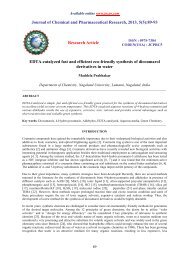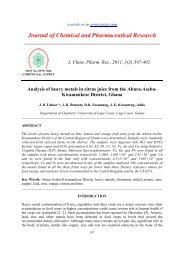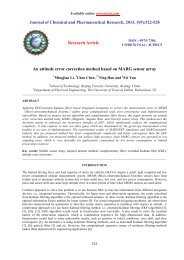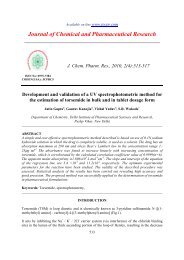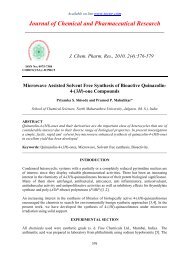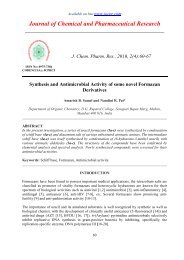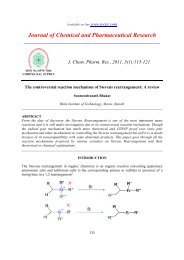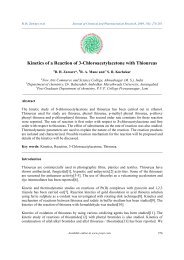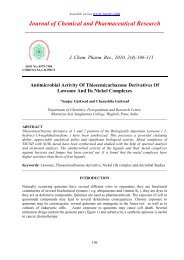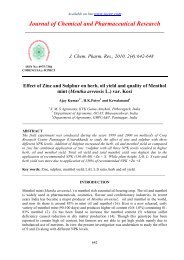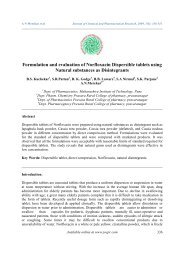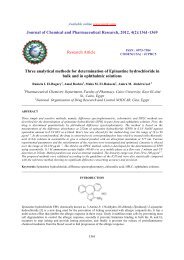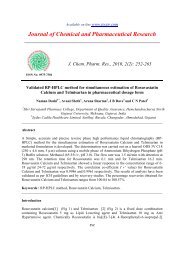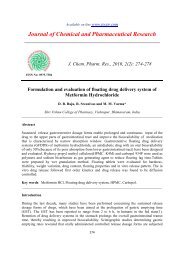Harrisonia abyssinica Oliv. - Journal of Chemical and ...
Harrisonia abyssinica Oliv. - Journal of Chemical and ...
Harrisonia abyssinica Oliv. - Journal of Chemical and ...
Create successful ePaper yourself
Turn your PDF publications into a flip-book with our unique Google optimized e-Paper software.
Available online www.jocpr.com<br />
<strong>Journal</strong> <strong>of</strong> <strong>Chemical</strong> <strong>and</strong> Pharmaceutical Research, 2012, 4(1):800-807<br />
Research Article<br />
800<br />
ISSN : 0975-7384<br />
CODEN(USA) : JCPRC5<br />
Morphological <strong>and</strong> anatomical studies <strong>of</strong> two medicinal plants: <strong>Harrisonia</strong><br />
<strong>abyssinica</strong> <strong>Oliv</strong>. (Simaroubaceae) <strong>and</strong> Spathodea campanulata P. Beauv.<br />
(Bignoniaceae) <strong>and</strong> their systematic significance<br />
1 *Mubo A. Sonibare <strong>and</strong> 1, 2 Osiyemi O. A.<br />
1 Department <strong>of</strong> Pharmacognosy, Faculty <strong>of</strong> Pharmacy, University <strong>of</strong> Ibadan, Ibadan Nigeria<br />
2 Plant Taxonomy Unit, Forestry Research Institute <strong>of</strong> Nigeria, Jericho, Ibadan, Nigeria<br />
_____________________________________________________________________________________________<br />
ABSTRACT<br />
The anatomy, morphology <strong>and</strong> trichome distribution <strong>of</strong> leaves <strong>of</strong> two medicinal plants: <strong>Harrisonia</strong> <strong>abyssinica</strong> <strong>Oliv</strong>.<br />
<strong>and</strong> Spathodea campanulata P. Beauv. from Nigeria were studied in order to underst<strong>and</strong> the usefulness <strong>of</strong> these<br />
characteristics for systematic purposes as well as provide useful pharmacopoeial information in addition to<br />
previous identification tests available on the species. Some anatomical characters such as the number <strong>and</strong> shape <strong>of</strong><br />
epidermal cells, number <strong>of</strong> palisade <strong>and</strong> spongy parenchyma layers <strong>of</strong> the leaf blade, <strong>and</strong> the trichome types provide<br />
information <strong>of</strong> taxonomical significance. The species showed variations in stomata types, epidermal cell shape, size<br />
<strong>and</strong> trichomes morphology. Most <strong>of</strong> the characters especially trichomes were diagnostic <strong>and</strong> used for distinguishing<br />
taxa. Trichomes were mostly multicellular <strong>and</strong> gl<strong>and</strong>ular on adaxial surface <strong>of</strong> H. <strong>abyssinica</strong>, on the two surfaces <strong>of</strong><br />
S. campanulata, they were gl<strong>and</strong>ular <strong>and</strong> non-gl<strong>and</strong>ular. Stellate hairs were observed in S. campanulata. Trichomes<br />
were well segmented in H. <strong>abyssinica</strong>. Trichomes <strong>of</strong> S. campanulata on abaxial surface had aggregates <strong>of</strong> 5 basalcells,<br />
in H. <strong>abyssinica</strong> there was just one basal cell. Leaf epidermal anatomy was reported for the first time in these<br />
species <strong>and</strong> was found taxonomically useful in the identification at the generic level.<br />
Key Words: Epidermis; Trichomes; Anatomy; medicinal plants; Nigeria.<br />
_____________________________________________________________________________________________<br />
INTRODUCTION<br />
The genus <strong>Harrisonia</strong> comprises 3 species, 2 <strong>of</strong> which occur in tropical Asia. <strong>Harrisonia</strong> <strong>abyssinica</strong> <strong>Oliv</strong>. is widely<br />
distributed in most tropical regions <strong>of</strong> Africa. H. <strong>abyssinica</strong> is variable, especially in size, shape <strong>and</strong> hairiness <strong>of</strong> the<br />
leaves. It is an evergreen, much-branched shrub or small tree, sometimes climbing, up to 6 (–13) m tall; bole <strong>and</strong><br />
larger branches with up to 2 cm long thorns on conical corky outgrowths; bark pale brown to grey; branches long<br />
<strong>and</strong> flexible. Leaves alternate, imparipinnately compound with 2–7 pairs <strong>of</strong> leaflets, up to 25 cm long, glabrous or<br />
hairy; stipules absent; petiole up to 3 cm long, with 2 recurved spines at base, petiole <strong>and</strong> rachis with 1–3 mm wide<br />
wings; petiolules 0–2 mm long; leaflets elliptical or broadly obovate to almost circular, 0.5–9 cm × 0.5–4 cm, base<br />
asymmetrical, cuneate to rounded, apex rounded to acuminate, margins variably toothed or entire. H. <strong>abyssinica</strong><br />
occurs in dry evergreen forest, forest edges, wooded grassl<strong>and</strong>, riverine forest <strong>and</strong> coastal areas, from sea-level up to<br />
1700 m altitude. It may form dense thickets on eroded soils. Annual rainfall in its area <strong>of</strong> distribution ranges<br />
between 150 mm <strong>and</strong> 2000 mm [1]. Medicinal applications <strong>of</strong> the plant include being used as treatment against a<br />
number <strong>of</strong> diseased conditions such as veneral diseases, fever, malaria, diarrhea, urinary problems <strong>and</strong> intestinal<br />
worms. Leaf sap is drunk for treatment in general body pains [2]. The methanolic <strong>and</strong> water extracts from the stem<br />
bark showed moderate antiplasmodial activity in-vitro <strong>and</strong> low toxicity in the brine shrimp toxicity test [3].<br />
Spathodea is a monotypic genus in the flowering plant family Bignoniaceae. The single species is commonly known<br />
as the African tulip tree, Flame-<strong>of</strong>-the-forest. The species is found throughout tropical Africa where it grows
Mubo A. Sonibare et al J. Chem. Pharm. Res., 2012, 4(1):800-807<br />
_____________________________________________________________________________________<br />
naturally in secondary forests in the high forest zone <strong>and</strong> in deciduous, transition, <strong>and</strong> savannah forests. It colonizes<br />
even heavily eroded sites, though form <strong>and</strong> growth rate suffer considerably on difficult sites. It is a tree that grows<br />
between 7–25 m (23–82 ft) tall <strong>and</strong> is native to tropical dry forests <strong>of</strong> Africa. This tree is planted extensively as an<br />
ornamental tree throughout the tropics <strong>and</strong> is much appreciated for its very showy reddish-orange or crimson (rarely<br />
yellow), campanulate flowers. It has become an invasive species in many tropical areas. The bark, flowers <strong>and</strong><br />
leaves are used in traditional medicine in Western Africa. Medicinal applications <strong>of</strong> S. campanulata include: the<br />
bark as laxative <strong>and</strong> antiseptics <strong>and</strong> the seeds, flowers <strong>and</strong> roots are used as medicine. The bark is chewed <strong>and</strong><br />
sprayed over swollen cheeks. The bark may also be boiled in water used for bathing newly born babies to heal body<br />
rashes. It is used in southwestern Nigeria for malaria treatment by drinking the decoction <strong>of</strong> its stem bark [4].<br />
Leaves <strong>of</strong> S. campanulata have been reported to possess antiplasmodial activity, astringent properties <strong>and</strong> relief for<br />
painful inflammatory conditions [5-7]. The leaf extract was also reported to possess both analgesic <strong>and</strong> anti-<br />
inflammatory properties <strong>and</strong> could be beneficial in alleviating painful inflammatory conditions [8].<br />
Morphologically <strong>and</strong> anatomically, the leaf is the most variable plant organ <strong>and</strong> the difference such as trichome is<br />
occasionally specific for species, genera or even families [9]. Information on foliar micromorphology has been<br />
reported <strong>of</strong> capable <strong>of</strong> shedding more light on plants structural features <strong>and</strong> their possible functional attributes [10].<br />
Several studies have reported the significance <strong>of</strong> foliar micromorphological features used to evaluate taxonomical<br />
delimitations <strong>of</strong> many plants [11-16]. This in effect has helped in correct identification <strong>and</strong> authentication <strong>of</strong> many<br />
plants hence finding usefulness in st<strong>and</strong>ardization <strong>of</strong> herbal products obtainable from various medicinal plants<br />
indigenous to most communities. Micromorphological characters <strong>of</strong> the leaf that have been used in some studies<br />
include: epidermal cell type, stomata, trichome <strong>and</strong> vascular bundle pattern <strong>and</strong> arrangement [17-21]. However, no<br />
such information is available on the anatomy <strong>of</strong> H. <strong>abyssinica</strong> <strong>and</strong> S. campanulata. The study was therefore<br />
undertaken to obtain information on micromorphological features <strong>of</strong> these two important medicinal plants which<br />
would help in their identification <strong>and</strong> authentication.<br />
EXPERIMENTAL SECTION<br />
Leaf epidermal anatomy <strong>of</strong> <strong>Harrisonia</strong> <strong>abyssinica</strong> <strong>and</strong> Spathodea campanulata were studied. Both specimens were<br />
collected in July 2011. H <strong>abyssinica</strong> was collected from Ifesowopo market, a few kilometers to Iseyin, <strong>and</strong> S.<br />
campanulata from Ilaju village along Eruwa road in Ido local government area both in Oyo state, Nigeria. The<br />
specimens were identified <strong>and</strong> authenticated by the second author at the Forest Herbarium, Ibadan (FHI), Nigeria<br />
where vouchers were also deposited as <strong>Harrisonia</strong> <strong>abyssinica</strong>-FHI 109474 <strong>and</strong> Spathodea campanulata-FHI 109471<br />
respectively. For epidermal studies Shultze’s method <strong>of</strong> maceration with improved technique was followed [22].<br />
Leaves were taken in pteri dishes, covered with 4 mL <strong>of</strong> concentrated nitric acid <strong>and</strong> kept under sun for 30 mins.<br />
Adaxial <strong>and</strong> abaxial epidermal peels obtained with the use <strong>of</strong> camel hair brush were rinsed in distilled water,<br />
bleached with one to two drops <strong>of</strong> Chloral hydrate for 30 sec. to remove chlorophyll, stained in 1 % aqueous<br />
Safranin O solution for 3 mins. <strong>and</strong> mounted in dilute glycerol.<br />
Leaf transverse sections (8-10 µm) were made by the histological technique, using a rotary microtome Leitz Wetzlar<br />
<strong>and</strong> inclusion in Eukitt [23]. The cross-sections were stained using Astra blue <strong>and</strong> counter stained with Saffranin O<br />
reagents. The sections were studied using an optical microscope Leitz Diaplan Germany 543669 <strong>and</strong> photographed<br />
with a Leica DFC 420 C camera.<br />
RESULTS AND DISCUSSION<br />
Macroscopy<br />
Sensory characters observed in the two medicinal plants are recorded in Table 1. In H. <strong>abyssinica</strong> leaf was fresh <strong>and</strong><br />
green in colour at the time <strong>of</strong> analysis; leaf is compound <strong>and</strong> shortly petiolate; lamina 3-5 cm long, 1-2 cm broad;<br />
oblanceolate to elliptic in shape; margin entire; apex is round or slightly acuminate, leaf base is attenuate <strong>and</strong><br />
venation is reticulate, leaf surface is glabrous above but pubescent beneath, texture is papery with a prominent<br />
midrib. In S. campanulata leaf was fresh <strong>and</strong> green in colour at the time <strong>of</strong> analysis; leaf is compound with a long<br />
petiole; lamina 10-15cm long, 6-8cm broad; elliptic to oblong in shape; margin entire; apex is acuminate, leaf base<br />
is slightly cuneate <strong>and</strong> venation is reticulate, leaf surface is glabrous, texture is papery with a prominent midrib.<br />
Microscopy<br />
Leaf epidermal studies <strong>of</strong> the taxa <strong>Harrisonia</strong> <strong>abyssinica</strong> <strong>and</strong> Spathodea campnulata were carried out to find the<br />
anatomical characters <strong>of</strong> taxonomic value. Epidermal <strong>and</strong> stomatal characters <strong>of</strong> the plants are presented in Table 2<br />
while anatomical features are recorded in Table 3.<br />
801
Mubo A. Sonibare et al J. Chem. Pharm. Res., 2012, 4(1):800-807<br />
_____________________________________________________________________________________<br />
Taxa<br />
H. <strong>abyssinica</strong><br />
Table 1. Morphological features <strong>of</strong> <strong>Harrisonia</strong> <strong>abyssinica</strong> <strong>and</strong> Spathodea campanulata<br />
Taxa<br />
Sensory characters H. <strong>abyssinica</strong> S. campanulata<br />
Composition Compound Compound<br />
Lamina<br />
Size 3-5 cm long; 1-2 cm wide 10-15 cm long; 6-8 cm wide<br />
Shape Oblanceolate-elliptic Elliptic to oblong<br />
Margin Entire Entire<br />
Apex Round to slightly acuminate Acuminate<br />
Base Attenuate Slightly cuneate<br />
Venation Reticulate Reticulate<br />
Surface Glabrous (pubescent beneath) Glabrous<br />
Mid-rib Prominent Prominent<br />
Texture Papery Papery<br />
Petiole<br />
Occurrence Petiolate Petiolate<br />
Character Short Long<br />
Table 2. Qualitative epidermal <strong>and</strong> stomata characters <strong>of</strong> <strong>Harrisonia</strong> <strong>abyssinica</strong> <strong>and</strong> Spathodea campanulata<br />
Leaf<br />
surface<br />
Adaxial<br />
Abaxial<br />
S. campanulata Adaxial<br />
Abaxial<br />
Cell shape<br />
CuboidrectangularCuboidrectangular<br />
Cuboid -<br />
rectangular<br />
Cuboidrectangular<br />
Cuticular<br />
ornamentation<br />
802<br />
Anticlinal wall<br />
pattern<br />
Stomata type<br />
Presence <strong>of</strong><br />
trichome<br />
Striation<br />
Thick undulating absent Present Striated<br />
Thin Straight-wavy Paracytic Present Striated<br />
Thick Wavy-undulating Anisocytic Present<br />
Thick Wavy-undulating<br />
Anisocytic<br />
(numerous)<br />
Present<br />
Table 3. Anatomical features <strong>of</strong> transverse sections <strong>of</strong> leaves <strong>of</strong> <strong>Harrisonia</strong> <strong>abyssinica</strong> <strong>and</strong> Spathodea campanulata<br />
Taxa<br />
Characters<br />
H. <strong>abyssinica</strong><br />
S. campanulata<br />
Leaf type Dorsivental Isobilateral<br />
No. <strong>of</strong> epidermis<br />
Lignification <strong>of</strong> cuticle<br />
One One<br />
Mesophyll differentiation Differentiated Undifferentiated<br />
No. <strong>of</strong> palisade layer 2 -<br />
Spongy parenchyma Isodiametric, 3-4 celled disjointed<br />
Trichome type<br />
Crystals<br />
Short <strong>and</strong> long unicellular <strong>and</strong> multicellular, stellate, 3-4 celled gl<strong>and</strong>ular Gl<strong>and</strong>ular <strong>and</strong> non-gl<strong>and</strong>ular<br />
Oil globules many many<br />
Type <strong>of</strong> Xylem vessel Lignified spiral vessels<br />
Vascular bundle pattern Central, 4-6 celled xylem (formed Convex arc) Collateral, 3-4 celled xylem<br />
In H. <strong>abyssinica</strong>, epidermal cells have undulating anticlinal walls on the adaxial surface <strong>and</strong> straight to wavy on the<br />
abaxial. Cells are striated (Fig. 1 A-D). Both surfaces have many oil globules; short unicellular trichomes with<br />
multicellular base as well as stellate trichomes. Some <strong>of</strong> the cells on the abaxial surface are lignified. In S.<br />
campanulata, epidermal strips on both surfaces possess wavy to undulating anticlinal walls <strong>and</strong> many oil globules.<br />
Different types <strong>of</strong> trichomes were seen on both surfaces; numerous unicellular non-gl<strong>and</strong>ular, multicellular nongl<strong>and</strong>ular<br />
as well as multicellular gl<strong>and</strong>ular on the adaxial surface; short multicellular non-gl<strong>and</strong>ular trichomes on<br />
the abaxial (Fig. 2 E-H).<br />
Transverse sections <strong>of</strong> leaf blades <strong>of</strong> H. <strong>abyssinica</strong> <strong>and</strong> S. campanulata are shown in Fig. 3 (I-J). In H. <strong>abyssinica</strong><br />
lamina is dorsiventral with single-layered epidermis on both surfaces <strong>and</strong> thick cuticle (Fig. 3 I). Epidermal cells are<br />
cuboid-rectangular in shape <strong>and</strong> are compactly arranged. The lower epidermis is also single layered with thin<br />
cuticle <strong>and</strong> many stomata hence the leaf is hypostomatic. Mesophyll is differentiated into palisade <strong>and</strong> spongy<br />
parenchyma with 2 layers <strong>of</strong> palisade parenchyma adjoined to the upper epidermis. Spongy tissues are isodiametric,<br />
3-4 cells thick <strong>and</strong> loosely connected. The T.S. <strong>of</strong> S. campanulata leaf is isobilateral having single-layered epidermis<br />
on both sides <strong>and</strong> thick cuticle. Epidermal cells are cuboid-rectangular in shape. Mesophyll is undifferentiated.<br />
Spongy cells are disjointed (Fig. 3 J). Mid-rib <strong>of</strong> H. <strong>abyssinica</strong> shows a narrow protuberance at the ventral side <strong>and</strong><br />
2 layers <strong>of</strong> epidermis (Fig. 3 K-L). The protuberance on the dorsal side is wide; 3-4 celled multicellular trichomes<br />
are present on the protuberances. Vascular bundles are centrally placed with 4-6 celled xylem forming a convex arc<br />
for the phloem. Mid-rib region in S. campanulata formed a prominent convex protrusion at the dorsal surface,<br />
Not<br />
striated<br />
Not<br />
striated
Mubo A. Sonibare et al J. Chem. Pharm. Res., 2012, 4(1):800-807<br />
_____________________________________________________________________________________<br />
internally bearing bundles <strong>of</strong> lignified spiral xylem vessels which could be as a result <strong>of</strong> secondary thickening (Fig.<br />
3 M-N). Multicellular trichomes with swollen basal cells are present at the protuberances <strong>of</strong> the mid-rib. 7 vascular<br />
bundles are collaterally arranged with phloem alternately arranged at the base <strong>of</strong> 3-5 celled xylem. Central pith bears<br />
large collenchymatous cells (Fig. 3 N).<br />
A B<br />
C D<br />
Fig. 1: (A-B) Adaxial epidermis <strong>of</strong> H. <strong>abyssinica</strong> (showing undulating cell wall pattern <strong>and</strong> many oil globules);<br />
(C-D) Abaxial epidermis <strong>of</strong> H. <strong>abyssinica</strong> (C showing long uniseriate trichome <strong>and</strong> many paracytic stomata; D<br />
shows straight <strong>and</strong> wavy epidermal cells)<br />
803
Mubo A. Sonibare et al J. Chem. Pharm. Res., 2012, 4(1):800-807<br />
_____________________________________________________________________________________<br />
E F<br />
G H<br />
Fig. 2: (E-F) Adaxial epidermis <strong>of</strong> S. campanulata (showing wavy-undulating cell wall pattern, oil globules<br />
<strong>and</strong> short multicellular trichome); (G-H) Abaxial epidermis <strong>of</strong> S. campanulata (showing trichome <strong>and</strong><br />
numerous anisocytic stomata)<br />
804
Mubo A. Sonibare et al J. Chem. Pharm. Res., 2012, 4(1):800-807<br />
_____________________________________________________________________________________<br />
I<br />
K<br />
M<br />
Pa<br />
Lt Gl<br />
Sxv<br />
J<br />
L<br />
N<br />
Figure 3 (I-J) Cross-sections <strong>of</strong> the leaf blades <strong>of</strong> H. <strong>abyssinica</strong> <strong>and</strong> S. campanulata (Pa: Palisade parenchyma, arrows in J<br />
show stomata); (K-L) Mid rib region <strong>of</strong> H. <strong>abyssinica</strong> (Lt: L-shaped trichome, Gl: gl<strong>and</strong>ular trichome, arrow in L shows<br />
4-6 celled xylem); (M-N) Mid rib region <strong>of</strong> S. campanulata (Sxv: Spiral xylem vessels)<br />
805<br />
Pi
Mubo A. Sonibare et al J. Chem. Pharm. Res., 2012, 4(1):800-807<br />
_____________________________________________________________________________________<br />
The presence <strong>of</strong> gl<strong>and</strong>ular <strong>and</strong> non-gl<strong>and</strong>ular trichomes on the two surfaces <strong>of</strong> S. campanulata is comparable to the<br />
observations made on foliar trichomes <strong>of</strong> Tetradenia riparia (Hochst.) Codd (Lamiaceae) where gl<strong>and</strong>ular <strong>and</strong> nongl<strong>and</strong>ular<br />
trichomes were present in abundance on both the adaxial <strong>and</strong> abaxial surfaces [24]. Also in our study<br />
anisocytic stomata were found on both surfaces <strong>of</strong> S. campanulata (i.e. leaf is amphistomatic) but numerous on the<br />
abaxial surface.<br />
In medicinal plants, trichome characters have been reported to act as biomarkers to identify the plant even in the raw<br />
material or powder form [25-27]. The presence <strong>of</strong> gl<strong>and</strong>ular trichomes in many <strong>of</strong> the medicinal plants is considered<br />
indicative on the concentration <strong>of</strong> secondary metabolites with pesticidal, pharmacological, <strong>and</strong> fragrant properties<br />
[28].<br />
The results <strong>of</strong> our study in line with those reported in several other studies for other plants [18, 19, 27, 29-32]<br />
present morpho-anatomical features in H. <strong>abyssinica</strong> <strong>and</strong> S. campanulata for the first time. These<br />
micromorphological characters in addition to existing macro-characters <strong>of</strong> the genera would be useful in correct<br />
identification <strong>and</strong> authentication <strong>of</strong> the plants.<br />
Acknowledgements<br />
The authors are grateful for permission to carry out histological analysis at the Institüt für Spezielle Botanik,<br />
Universtät D-55099 Mainz, Germany. The technical support <strong>of</strong> Barbara Dittman <strong>and</strong> M. Junginger in slicing <strong>and</strong><br />
photographing the sections is also gratefully acknowledged. We also thank A. A. Elujoba, Pr<strong>of</strong>essor: Department <strong>of</strong><br />
Pharmacognosy for his useful comments on the manuscript. Financial support for this research came from the West<br />
African Health Organization Pharmacopoeial project.<br />
REFERENCES<br />
[1] JO Kokwaro, Medicinal plants <strong>of</strong> East Africa, 2nd Edition, Kenya Literature Bureau, Nairobi, Kenya, 1993, p.<br />
401.<br />
[2] HM Burkill, The useful plants <strong>of</strong> West Tropical Africa. 2nd Edition, Volume 5, Families S–Z, Addenda. Royal<br />
Botanic Gardens, Kew, Richmond, United Kingdom. 2000, p. 686.<br />
[3] Balde, A.M.; Pieters, L.; De Bruyne, T.; Geerts, S.; V<strong>and</strong>en Berghe, D.A. <strong>and</strong> Vlietinck, A. 1995. Phytomedicine<br />
1 (4), 299–302.<br />
[4] Adebayo, J. O. <strong>and</strong> Krettli, A. U. 2011. J. Ethnopharmacol.133: 289-302.<br />
[5] JM Dalziel, The useful plants <strong>of</strong> West Tropical Africa. The Crown Agents for Overseas Colonies, London, 1948,<br />
p. 397-399.<br />
[6] <strong>Oliv</strong>er, Medicinal plants in Nigeria. Nigerian College <strong>of</strong> Arts, Science <strong>and</strong> Technology, Ibadan, Nigeria, 1960,<br />
pp: 23.<br />
[7] Makinde, J.M.; Amusan, O.G. <strong>and</strong> Adesogan, E.K. 1988. Planta Med. 54, 122-125.<br />
[8] Ilodigwe, E. E. <strong>and</strong> Akah, P. A. 2009. Asian J. Med. Sci. 1(2), 35-38.<br />
[9] Bunawan, H.; Talip, N. <strong>and</strong> Noor, N. M. 2011. Aust. J. Crop Sci. 5(2), 123-127.<br />
[10] Ashafa, A. O. T.; Grierson, D. S. <strong>and</strong> Afolayan, A. J. 2008. Pak. J. Biol. Sci. 11 (13), 1713-1717.<br />
[11] WC Dickison, Integrative Plant Anatomy. Academic Press, San Diego, CA, 2000.<br />
[12] Sonibare, M.A.; Jayeola, A.A. <strong>and</strong> Egunyomi, A. 2005. Bot. Bull. Acad. Sinica 46, 231-238.<br />
[13] Sonibare, M.A.; Jayeola, A.A. <strong>and</strong> Egunyomi, A. 2006. J. Appl. Sci. 6 (15), 3016-3025)<br />
[14] Y asmin, G.; Khan, M. A.; Shaheen, N. <strong>and</strong> Hayat, M. Q. 2009. Int. J. Agric. Biol. 11(3): 285-289.<br />
[15] Kahraman, A. <strong>and</strong> Celep, F. 2010. Aust. J. Crop Sci. 4(5), 369-371.<br />
[16] Gostin, I. N. 2011. Pak. J. Bot. 43(2), 811-820.<br />
[17] Ayodele, A.E,; Olowokudejo, J.D. 2006. South Afri. J. Bot. 72(3), 442-459.<br />
[18] Adedeji, O.; Ajuwon, O.Y. <strong>and</strong> Babawale, O.O. 2007. Int. J. Bot. 3(3), 276-282.<br />
[19] Bhatt, A.; Naidoo, Y. <strong>and</strong> Nicholas, A. 2010. Biol. Res. 43, 403-409.<br />
[20] Yasmin, G.; Khan, M.A.; Shaheen, N. <strong>and</strong> Hayat, M.Q. 2010. Afri. J. Biotechnol. 9(25), 3759-3768.<br />
[21] Senthamari, R.; Kirubha, T.S.V.; Gayathri, S. 2011. J. Chem. Pharm. Res., 3(6), 829-838.<br />
[22] NS Subrahmanyam, Labortary Manual <strong>of</strong> Plant Taxonomy. Vikas publishing house PVT. Ltd. New Delhi,<br />
1996.<br />
[23] Canne-Hilliker, J. M. And Kampny, C. M. 1991. Can. J. Bot. 69 (9), 1935-1950.<br />
[24] Gairola, S.; Naidoo, Y.; Bhatt, A. <strong>and</strong> Nicholas, A. 2009. Flora Morphol. Distr. Funct. Ecol. Plants 204 (4),<br />
325-330<br />
[25] Ragusa, S.; De-Pasquale, R.; Flores, M.; Germano, M. P.; Sanogo, R. <strong>and</strong> Rapisarda, A. 2001. II Farmaco 56<br />
(5-7), 361-363.<br />
[26] Gohil, D.; Raole, V.M. <strong>and</strong> Daniel, M. 2007. Herbal Technol.: Recent Trends. Prog.<br />
[27] Jayeola, A. A. 2009. J. Med. Plants Res. 3(5), 438-442.<br />
806
Mubo A. Sonibare et al J. Chem. Pharm. Res., 2012, 4(1):800-807<br />
_____________________________________________________________________________________<br />
[28] Duke, S.O. 1994. Int. J. Plant Sci. 155, 617-620.<br />
[29] Rapisarda, A.; Iauk, L. <strong>and</strong> Ragusa, S. 1997. Econ. Bot. 51 (4), 385-391.<br />
[30] Dinc M.; Pinar, N. M.; Dogu, S. <strong>and</strong> Yildirimli, S. I. 2009. Acta Biol. Cracov. Bot. 51 (1), 45–54.<br />
[31] Eltahir, A.S. <strong>and</strong> AbuReish, B.I. 2010. J. Chem. Pharm. Res. 2(3), 260-268.<br />
[32] Sarma, D.S.K. <strong>and</strong> Babu, A.V.S. 2011. J. Chem. Pharm. Res. 3(4), 237-244.<br />
807



